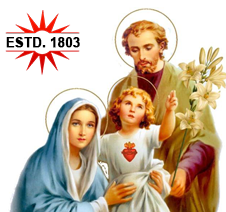


| POTHEN KURUVILLA | |
| KURUVILLA | |
| 4 | |
| Male | |
| Married | |
|
Sons 1 . KURUVILLA KOCHANDY 2 . KURUVILLA POTHEN 3 . KURUVILLA KOCHUKURUVILLA | |
Pothen Kuruvilla (1750-1820), the founder of Olassa family, Changanacherry belonged to the fourth generation of the Olassa Elanjimoottil family who came and settled down in Changanacherry and established Olassa family in Changanacherry . He was born as the son of Pothen Elanjimoottil, Olassa, Kottayam. After the demise of his father, his mother and children moved to Thathampally, Alappuzha. When Pothen Kuruvilla became major , the property of his father, which was looked after by his father’s brother came to his possession. So he settled in Elanjimoottil. Pothen Kuruvilla married from Puthankavu, Palliveettil, a Catholic family. Though all the other members of Elanjimoottil family joined the Jacobite Rite, Pothen Kuruvilla remained with the Catholic Church due to his closeness to mother’s catholic family and also because he married from a catholic family. He became member of ‘Kareepally’ He was a member of the palliyogum also. Now it would be interesting to know the history of the Catholic church then and the 1653 Synod of Udayamperoor. When Koonamkurisu Oath took place in 1653, the members of Catholic church, then known as ‘Nazranee Christians’ split into two. With the arrival of a Jacobite Bishop, one section accepted him and was known to be Puthenkuttu. It was due to the dominance of the Portuguese Bishop over the catholic community. After the Synod of Udayamperoor major portion of the people remained as catholics approving the Pope and they came to be known as Pazhayakuttu. While leading a happy and prosperous life alongwith his wife and children at Elanjimoottil, Olassa, the dominance of Kattakkayam family over the palliyogam of Kareepally could not be tolerated by Pothen Kuruvilla. He thought of leaving his native place at Olassa and going to Changanacherry. He heard of the famous Changanacherry Catholic church from his only sister Anna who was married to a catholic family in Changanacherry. This family connection and his appreciation of the catholic church made him to settle in Changanacherry. The arrival of Christians in Changanacherry and the establishment of Catholic Church Changanacherry was part of ‘Nanthuzhai nadu’ of the second Kulasekhara dynasty. As per A.D. 976 Thrikodithanam Decree of Kulasekhara, Emperor Bhaskara Ravi Verma-1, the name of ‘Nanthuzhai Nadu’ was mentioned . By 12th century AD the Kulasekhara dynasty and Nanthuzhai Nadu vanished. Later Nanthuzhai Nadu and part of Munjanadu became ‘Vembala Nadu’. Changanacherry then became part of Vembala Nadu. Later Vembala Nadu was divided into ‘Vadakkumcoore’ and ‘Thekkumcoore’. Changanacherry became part of Thekkumcoore. The King of Thekkumcoore, had few palaces and one among them was ‘Neerazhy’ Palace in Puzhavathu. The Nazarani Christians began to come and settle in Changanacherry by the invitation of Hindu Kings. They were brought to sanctify the oil in Subramania Temple. Kuthukallumkal Christians from Edappally were brought to Changanacherry, Kallarackal Mathew Tharakan who was brought from Kuruppumpady later became the Army chief of the King. Mathew Tharakan was said to be the founder of Changanacherry Catholic church. Before the construction of church in Changanacherry, the catholics of Changanacherry had to depend on the church at Niranam for their religious matters. Once Mathew Tharakan and followers went to Niranam for attending Mass. When they reached the church, the service was over and Tharakan got very much annoyed. The King saw his Army Chief depressed and he realized the reason. Immediately the King assigned Mathew Tharakan land for constructing a church. The measurement of the land later became the name of the place as ‘Changanacherry’. The King later constructed a temple called Devi Keshthra and then a Masjid for the muslim population. This is said to be the communal harmony of Changanacherry. The king built these in such a way that he could see the ‘Chirappu’ of Devi Temple, ‘Channanakudam’ of Juma Masjid and Christmas of the Christian church sitting in his ‘Ezhunullathu Pura’. Later Travancore army led by Ramayyer and Dilanay invaded Changanacherry and after some years, Thekkumcoore became part of Travancoore. It is presumed that Changanacherry church was constructed around AD 1117. Inauguration of Changanacherry Chanda (Market) Changanacherry market started functioning during AD 1805. It was inaugurated by Veluthampy Delava of Travancore by selling an elephant. The exact place of the market was on the eastern side of the boat jetty. It is believed that even before the inauguration of the market by Veluthampy, there was a Chowka ie.Custom House at Changancherry. It was at this chowka junction that the famous Anchu Vilakku of Changanacherry was erected. Near the chowka there was a Pandakasala ie.godown where salt and pepper were stored. The government officer in change of the Pandakasala was known as ‘Kurumulaku madiseelakaran. Pothen Kuruvilla of Elanjimood Olassa was aware that business would help him to prosper and progress in life. So he purchased land near the market place. The name of the land allotted to him was ‘Kuzhivalthundy purayidom’. He constructed a house using the expertise of Nattakom Thachen, a renowned Thachu Sasthranjan of the time. Only after the purchasing the land and constructing a house, he sold the properties at Olassa. After residing at the new house he gave up the name ‘Elanjimood’ and accepted ‘Olassa’ as his family name. It is believed that during the time of allotment of land there was an order that those who purchased land for dwelling purpose should use the name of the place from where they came, as their family name. Family names like Kuttamperoor Chackalackal, Changankerry, Chackkalackal, Koduppunna Valia Veettil were such names. Pothen Kuruvilla constructed additional rooms adjacent to his house for commercial purposes. He started money lending business there. During those days there was no such business at Changanacherry. Even the Banking business was started in Changanacherry only in 19th century. The Tamil Brahmins from Thirunelvely although started lending money viz Hundy business, the natives were not interested. Due to the money lending business, Pothen Kuruvilla bcame rich and also became a known person of the place. This helped him to join the palliyogum of Changanacherry catholic church . The church had only very low income and there were no one to administer the church properly. The then palliyogam (parish committee) selected Pothen Kuruvilla as ‘Kanakkan’ – Accountant of the church. In those days, the job of Trustee/ Accountant was a honourable job and a honourary service. The major income of the church was vilakkenna ie.oil for lighting lamps at Kochupally. Pothen Kuruvilla found that a good amount of vilekkenna was taken away by the people. In order to get money for the church, he thought of selling the oil in excess. This made few people to become his enemies. However he kept the vilakkenna under lock and key. His enemies, after influencing the council, raised some allegations against him fixing reasonability on Pothen Kuruvilla for the financial losses to the church. They had managed to penalise him asking him to remit this amount in church account. Pothen Kuruvilla however was not corrupt. But later they insisted his son Kuruvilla Kochandy to repay this amount when he approached the church for Pattakuri for his son Thoma to join seminary. Kuruvilla Kochandy remitted 2500 chakrams, the then coin of the time and made a petition to the Bishop of Varappolly The Bishop engaged an enquiry commission and the Commission found that Pothen Kuruvilla was innocent.The Bishop ordered to pay back the amount penalised against Pothen Kuruvilla to his son Kuruvilla Kochandy. But Kuruvilla Kochandy did not accept the money, instead gave it back to the church. Pothen Kuruvilla was a god fearing, pious, law abiding gentleman of the time. His date of birth and date of death are not known. It is believed that he lived between 1760-1820 A.D. The home he constructed in Chanda stands as his memorial. He had three sons:
| |
| Yes | |



